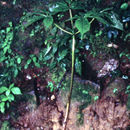Comments
provided by eFloras
This species is used medicinally.
- license
- cc-by-nc-sa-3.0
- copyright
- Missouri Botanical Garden, 4344 Shaw Boulevard, St. Louis, MO, 63110 USA
Description
provided by eFloras
Herbs, perennial, ca. 50 cm tall. Rootstock short, with 2-5 fleshy roots, fusiform, 2-4 cm, ca. 1 cm in diam. Leaves usually 4, verticillate at apex of stem, palmately compound; bases of petiole and petiolules with numerous lanceolate, stipulelike appendages; leaflets 3 or 4, obovate-elliptic to obovate-oblong, 9-10 × 3.5-4 cm (lateral ones smaller), membranous, abaxially glabrous, adaxially setose on veins (trichomes 1.5-2 mm), base attenuate, margin biserrate, apex long caudate-acuminate. Inflorescence a solitary, terminal umbel 20-50-flowered; peduncle ca. 12 cm; pedicels ca. 1 cm, glabrous. Ovary 2-carpellate; styles 2 divided, reflexed.
- license
- cc-by-nc-sa-3.0
- copyright
- Missouri Botanical Garden, 4344 Shaw Boulevard, St. Louis, MO, 63110 USA
Distribution
provided by eFloras
S Xizang [?Bhutan, ?N India, Nepal].
- license
- cc-by-nc-sa-3.0
- copyright
- Missouri Botanical Garden, 4344 Shaw Boulevard, St. Louis, MO, 63110 USA
Habitat
provided by eFloras
Forests; 2400-4200 m.
- license
- cc-by-nc-sa-3.0
- copyright
- Missouri Botanical Garden, 4344 Shaw Boulevard, St. Louis, MO, 63110 USA
Synonym
provided by eFloras
Aralia pseudoginseng (Wallich) Bentham ex C. B. Clarke; A. quinquefolia (Linnaeus) Decaisne & Planchon var. pseudoginseng (Wallich) Burkill.
- license
- cc-by-nc-sa-3.0
- copyright
- Missouri Botanical Garden, 4344 Shaw Boulevard, St. Louis, MO, 63110 USA
Distribution
provided by Plants of Tibet
Nepal
Evolution
provided by Plants of Tibet
The phylogeny of Panax using the ITS sequences of nuclear ribosomal DNA (Wen and Zimmer, 1996; Lee and Wen, 2004). The ITS suggests that (1) the Himalayan Panax pseudoginseng is closely related to P. stipuleanatus from southwestern China; (2) the P. pseudoginseng-P. stipuleanatus clade is basal among the Asiatic species. Wen indeed found Panax pseudoginseng sympatric with P. bipinnatifidus in the type locality of the former and in other locations in Nepal as well. However, Yoo et al. (2001) found that the two species collected in the same location had very distinct chloroplast DNA and nuclear ribosomal ITS profiles. Based on the morphological variation and the phylogenetic relationships, Wen (2001) proposed a classification scheme for Panax, in which Panax pseudoginseng belong to Subgenus Panax, Section Pseudoginseng.
General Description
provided by Plants of Tibet
Tubers single or fascicled, fusiform. Rhizomes short. Base of aerial stem with persistent glabrous and membranaceous scales. Stem glabrous, 25-50 cm long. Leaves 3-4, with persistent stipules; leaflets lanceolate or narrowly elliptic, upper surface with bristly hairs along veins and veinlets, lower surface glabrous. Inflorescence with 1-3 umbels, each 40-65 flowered. Fruit red, 1-2 seeded. Seeds broadly kidney-shaped, 7-7.5 mm long, 6-6.5 mm wide, 5-6 mm thick, surface rough.
Panax pseudoginseng
provided by wikipedia EN
Panax pseudoginseng is a species of the genus Panax. Common names include pseudoginseng, Nepal ginseng and Himalayan ginseng. Pseudoginseng belongs to the same scientific genus as ginseng. In Latin, the word panax means "cure-all", and the family of ginseng plants is one of the best-known herbs.
See also
References

- license
- cc-by-sa-3.0
- copyright
- Wikipedia authors and editors
Panax pseudoginseng: Brief Summary
provided by wikipedia EN
Panax pseudoginseng is a species of the genus Panax. Common names include pseudoginseng, Nepal ginseng and Himalayan ginseng. Pseudoginseng belongs to the same scientific genus as ginseng. In Latin, the word panax means "cure-all", and the family of ginseng plants is one of the best-known herbs.
- license
- cc-by-sa-3.0
- copyright
- Wikipedia authors and editors

